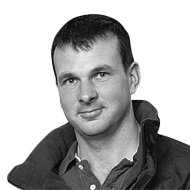With strong growth through most of May, by the time June came it looked as though grass was going to run out of steam – until the rain came that was.
Last week, I measured growth at 120kg dry matter per hectare (DM/ha).
At this rate, a paddock grazed today would need to be grazed again in 12 or 13 days; otherwise it will be too stemmy and either won’t be grazed out as cleanly, or else the bulk tank will take a hit.
Over the past 10 days, we have been doing a lot of baling between the wet days to try to control sward quality and build up a supply of bales to feed to the high-yielding group after second cut comes in.
And just to keep things complicated, up to last week we had been running three groups of cows. The low group has been at grass full-time, the mid group has been out by day and in at night (they all graze together during the day and the draught gate sorts them leaving the parlour).
he high group are housed full-time and will remain so for the time being as they are currently averaging just shy of 40 litres per day.
After measuring growth over the last few days, and seeing grass powering ahead, I decided to merge the low and mid group. To maximise intakes of grass and keep production up as much as possible, the electric fence to split paddocks has been wound up and left back in the shed for the time being – should the weather break and ground conditions suffer we will use it again to control where the cows graze. But, for the moment, each paddock is lasting the group for about two days.
Leatherjackets
Having had leatherjackets confirmed in the grazing platform, the current project is getting the affected paddocks back to full productivity.
Over the past week, we grazed two of the damaged paddocks, then mowed the residual grass, raked it up and baled it (the three bales were dumped). Once we had a good clean stubble, we were able to drill new seed at the rate of 10kg/acre.
I had been told that for over-seeding/stitching to be a success, it is important to use a grass variety with a large seed size as it has more energy and will be more vigorous when it comes to germination. The varieties used were Dunluce and Dunloy – both tetraploid and both later heading with good sward density.
No clover was used as I find the weeds are too hard to control – I prefer no clover and no weeds as opposed to some clover and lots of weeds. I plan now to repeat this operation on the rest of the damaged paddocks over the coming months.
Brexit
It will be interesting to see what proposals come out of the Ulster Farmers’ Union consultation on what form farm support will take after Brexit. In my opinion, for what it’s worth, I think the money should be re-directed to better reward the good farmers instead of propping up non-productive landowners who are only farming the system.
If support could in some way be linked to efficiency, it would be the quickest way to raise standards right across the industry. If, for example, the better farmers can make more use of forage, cut out waste, and be quick to adapt to new energy-saving technology, why can’t the rest? An option might be to link support to the carbon footprint per unit of output of an individual farm business.
Or, perhaps it’s too much to expect the powers that be to have the vision to do anything so radical. But whatever happens, why should non-productive landowners be entitled to a subsidy just because they have been left a bit of ground which they can’t farm properly?






 This is a subscriber-only article
This is a subscriber-only article










SHARING OPTIONS: